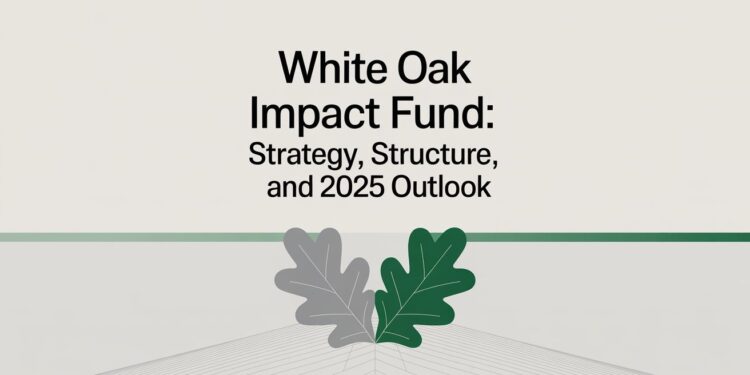Introduction
The White Oak Impact Fund has become one of the more prominent private credit strategies designed to marry financial returns with measurable positive outcomes. As investors increasingly demand impact-oriented vehicles that deliver both yield and purpose, White Oak Global Advisors positioned this fund as a bridge between secure lending and sustainable finance. Registered in Luxembourg as a SCSp SICAV-RAIF, the fund is structured to attract professional and qualified investors who want exposure to small and medium-sized enterprise (SME) lending while also ensuring their capital contributes to broader environmental and social goals.
In 2025, the White Oak Impact Fund continues to expand its visibility through investor days, impact measurement partnerships, and governance frameworks that highlight accountability. This article provides a comprehensive overview of the fund—its background, what it invests in, how it measures impact, and why it has gained attention among allocators searching for ESG-driven credit strategies.
Snapshot of the White Oak Impact Fund
At its core, the White Oak Impact Fund is an impact-oriented direct lending vehicle. It was designed to deploy capital into secured loans made to SMEs, a segment of the economy that often struggles to obtain competitive financing from traditional banks. By lending to these enterprises, the fund not only seeks to generate stable and predictable returns for investors but also aims to foster job creation, energy efficiency, and sustainable community growth.
The structure of the fund, a Special Limited Partnership (SCSp) wrapped within a SICAV-RAIF in Luxembourg, gives it flexibility and efficiency while complying with European investment regulations. Investors gain exposure through a master-feeder structure, which allows for both onshore and offshore participation, depending on their jurisdiction.
Latest Developments in 2025
As of 2025, registry records show updates to the fund’s legal entity identifiers, reinforcing its compliance and transparency. White Oak has also showcased the fund prominently during its Investor Day: Impact, where the portfolio’s contribution to measurable environmental and social outcomes was reviewed in detail.
Another important milestone has been the continuation of governance through the Impact Advisory Board, originally chaired by Roksana Ciurysek-Gedir. This board plays a vital role in guiding impact measurement, ensuring alignment with global frameworks, and preventing the risk of “impact-washing.”
Equally important, the White Oak Impact Fund maintains its relationship with Global Impact, a measurement partner whose system-level methodology allows the fund to quantify avoided emissions, job creation, and other non-financial returns in ways that resonate with institutional allocators.
What the Fund Invests In
The White Oak Impact Fund channels capital into secured loans for SMEs, particularly in developed markets such as the United States, the United Kingdom, Canada, and Australia. These regions were highlighted early in the fund’s strategy, given their stable regulatory frameworks and large base of under-served enterprises.
Borrowers often use proceeds for:
- Growth financing to expand operations
- Working capital to stabilize cash flow
- Equipment purchases or upgrades
- Asset-backed financing tied to receivables or inventory
The fund emphasizes lending to businesses that can generate both financial returns and impact outcomes. Examples include healthcare providers improving community access, manufacturers reducing their carbon footprint, or companies enabling job opportunities in economically disadvantaged areas.
Thematic Impact Priorities
The impact lens of the White Oak Impact Fund covers several broad themes:
- Climate and Resource Efficiency – Funding enterprises that reduce energy consumption, invest in renewable energy, or adopt circular economy principles.
- Inclusive Growth – Supporting SMEs that create sustainable jobs, especially in regions where access to traditional finance is limited.
- Essential Services – Enabling access to healthcare, education, and other vital social infrastructure.
By aligning with these themes, the fund positions itself not just as a financial intermediary but as a facilitator of global sustainable development.
Structure and Investor Eligibility
The fund operates through a master–feeder structure, with a master partnership in Luxembourg and feeders tailored to different investor bases, including offshore participants. This is a common setup in alternative credit funds, designed to streamline portfolio management while ensuring regulatory efficiency.
As a Reserved Alternative Investment Fund (RAIF), the White Oak Impact Fund is open primarily to professional and qualified investors. This ensures that participants are capable of evaluating the complexities and risks of private credit vehicles. Minimum subscription sizes, lock-up periods, and redemption terms are set out in offering documents and vary depending on share class.
Impact Measurement and ESG Methodology
One of the most significant differentiators of the White Oak Impact Fund is its rigorous impact measurement system. Partnering with Global Impact, the fund applies a system-level measurement framework that tracks outcomes across multiple dimensions.
Typical key performance indicators (KPIs) include:
- Tons of carbon dioxide equivalent (tCO₂e) avoided
- Energy savings achieved by portfolio companies
- Jobs created or sustained, including those for underserved groups
- Diversity and inclusion metrics within borrower organizations
- Community-level improvements, such as healthcare access or educational support
This methodology not only ensures transparency but also provides investors with quantifiable evidence of the fund’s effectiveness in generating positive change.
Performance and Risk Considerations
As with any private credit fund, performance information is available primarily to existing and prospective investors through official documents. However, publicly accessible sources classify the White Oak Impact Fund as part of the firm’s broader direct-lending strategy, which has historically emphasized capital preservation through secured loans.
Key risk factors include:
- Credit and sector risk: SMEs are more sensitive to economic downturns.
- Illiquidity: Like most alternative funds, capital is locked for years.
- Impact measurement risk: Ensuring outcomes are genuine and verifiable.
- Currency risk: Cross-border lending can expose portfolios to FX volatility.
The fund mitigates these risks through collateralization, diversified exposure across industries and geographies, and active monitoring of portfolio companies.
Fees and Terms
The White Oak Impact Fund follows fee structures typical for private credit vehicles. Investors can expect a management fee charged on committed capital and a performance fee linked to net returns above a hurdle rate. Lock-up periods, redemption notice requirements, and side letter provisions are outlined in offering documents. While specifics vary by class, these terms are structured to align incentives between manager and investors.
Due Diligence Checklist for Investors
For allocators considering exposure to the White Oak Impact Fund, a structured due diligence process is essential. Key questions include:
- How does the fund’s strategy align with the overall portfolio’s risk/return profile?
- Which United Nations Sustainable Development Goals (SDGs) are targeted, and how are they measured?
- What third-party verification exists for reported impact data?
- How is performance attribution calculated across White Oak’s multiple vehicles?
- How independent and influential is the Impact Advisory Board?
These questions ensure that investors go beyond marketing materials to evaluate the fund’s true alignment with their values and financial objectives.
Comparisons and Alternatives
Compared to other impact-focused private credit funds, the White Oak Impact Fund stands out for its secured lending approach. While many peers focus on equity or venture-style impact strategies, White Oak positions itself as a lower-risk, income-generating option.
The Luxembourg RAIF structure is also notable, as it offers speed to market and flexible governance compared to traditional limited partnerships in Delaware or other jurisdictions. For investors, this means easier access to a regulated yet adaptable framework.
How to Invest
Interested investors typically begin by engaging with White Oak’s investor relations team, who provide the private placement memorandum (PPM), due diligence questionnaire (DDQ), and recent performance reports. Eligibility screening, know-your-customer (KYC) checks, and anti-money-laundering (AML) compliance are mandatory steps.
Depending on the vehicle variant, subscriptions may be made through capital commitments with periodic drawdowns or through an evergreen structure with defined liquidity windows. Minimums are generally set to ensure participation by institutional or sophisticated investors.
FAQs
Is the White Oak Impact Fund legitimate?
Yes. It is managed by White Oak Global Advisors, an established private credit manager, and registered in Luxembourg under a RAIF structure, with updated legal entity identifiers and SEC Form ADV references.
What does SCSp SICAV-RAIF mean?
It refers to a Luxembourg investment partnership designed for professional investors, combining limited partnership flexibility with regulatory oversight.
How does the fund measure impact?
Through Global Impact’s system-level framework, which tracks avoided emissions, jobs created, and other social/environmental outcomes.
Who chairs the Impact Advisory Board?
Originally established under the guidance of Roksana Ciurysek-Gedir, the board ensures independent oversight of impact goals.
Conclusion
The White Oak Impact Fund represents a compelling example of how private credit can evolve to meet modern demands for both return and responsibility. By focusing on SME lending, adopting rigorous ESG methodologies, and maintaining transparent governance structures, the fund has carved out a niche for investors seeking measurable impact without sacrificing financial discipline.
In 2025, as the debate around sustainable finance intensifies, the White Oak Impact Fund offers a model that emphasizes practicality, accountability, and long-term value creation. For allocators evaluating impact strategies, it remains a fund worth close consideration—both for its financial profile and its contribution to a more inclusive, sustainable economy.
Do Read: Ultimate Guide: How and Why to Buy Ezocards in 2025



















